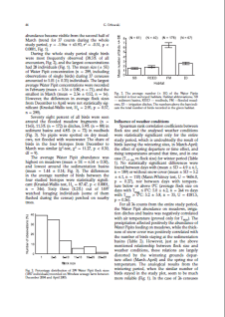
Object
Title: Habitat Selection and Winter Food Resources of the Water Pipit Anthus spinoletta in South-Western Poland
Subtitle:
Wybiórczość środowiskowa i zasoby pokarmowe zimowisk siwerniaka w południowozachodniej Polsce ; Habitat selection of wintering Water Pipits
Contributor:
Museum and Institute of Zoology, Polish Academy of Sciences
Publisher:
Museum and Institute of Zoology, Polish Academy of Sciences
Place of publishing:
Description:
Type of object:
Abstract:
In winter 2004/2005, 1532 Water Pipits were recorded during 37 censuses carried out along an established route on a sewage farm flooded with wastewater (Wrocław, SW Poland). Single birds were seen in nearly 39% of all 299 encounters, while the largest concentrations, between 16–28 individuals, accounted for 9%. 78% of all birds were observed on meadows flooded with communal wastewater. The remaining ones stayed around irrigation ditches (n = 172, 11.5%), sedimentation basins (n = 88, 5.9%) and reedbeds (n = 72, 4.8%). The mean size of the Water Pipit concentration was largest on the meadows (mean ± SE = 6.54 ± 0.50 individuals) and smallest at the sedimentation basins (mean = 1.44 ± 0.14). In this winter season (December-first half of March), rainfall enlarged numbers of birds to forage on the meadows, and the thickness of the snow cover was positively correlated with bird abundance at the sedimentation basins. The dominant available prey items inhabiting the warm wastewater were Diptera larvae (96%), 88% of which belonged to the genus Eristalis. The mean (± SD) invertebrate biomass was highest in the basin sediments (1.03 ± 1.14 g/dm3 of deposits), and lowest on the flooded meadows (0.20 ± 0.37 g/dm3 of deposits). The results point to the significance of the artificial environmental conditions created by warm sewage water, which enable the birds to remain largely independent of the weather and thus to overwinter in a cold region of central Europe.
Relation:
Volume:
Issue:
Start page:
End page:
Detailed Resource Type:
Format:
Resource Identifier:
oai:rcin.org.pl:55562 ; 10.3161/068.041.0110
Source:
MiIZ PAN, sygn. P.4568 ; MiIZ PAN, sygn. P.257 ; click here to follow the link
Language:
Language of abstract:
Rights:
Prawa zastrzeżone - dostęp ograniczony
Terms of use:
Digitizing institution:
Muzeum i Instytut Zoologii Polskiej Akademii Nauk
Original in:
Biblioteka Muzeum i Instytutu Zoologii PAN
Access:
Object collections:
- Digital Repository of Scientific Institutes > Partners' collections > Museum and Institute of Zoology PAS > Scientific Journals
- Digital Repository of Scientific Institutes > Partners' collections > Museum and Institute of Zoology PAS > MIZ PAN Publications > Acta Ornithologica
- Digital Repository of Scientific Institutes > Literature > Journals/Articles
Last modified:
Aug 8, 2023
In our library since:
Jul 29, 2015
Number of object content downloads / hits:
6
All available object's versions:
https://rcin.org.pl/publication/75744
Show description in RDF format:
Show description in RDFa format:
Show description in OAI-PMH format:
Objects Similar
Fichet-Calvet, E. Jomaa, I. Giraudoux, P. Ashford, R. W.
Goławski, Artur
Wojciechowska, Władysława Pęczuła, Wojciech Zykubek, Andrzej
Kłapa, Mieczysław
Prüffer, Jan (1890–1959)

 INSTYTUT ARCHEOLOGII I ETNOLOGII POLSKIEJ AKADEMII NAUK
INSTYTUT ARCHEOLOGII I ETNOLOGII POLSKIEJ AKADEMII NAUK
 INSTYTUT BADAŃ LITERACKICH POLSKIEJ AKADEMII NAUK
INSTYTUT BADAŃ LITERACKICH POLSKIEJ AKADEMII NAUK
 INSTYTUT BADAWCZY LEŚNICTWA
INSTYTUT BADAWCZY LEŚNICTWA
 INSTYTUT BIOLOGII DOŚWIADCZALNEJ IM. MARCELEGO NENCKIEGO POLSKIEJ AKADEMII NAUK
INSTYTUT BIOLOGII DOŚWIADCZALNEJ IM. MARCELEGO NENCKIEGO POLSKIEJ AKADEMII NAUK
 INSTYTUT BIOLOGII SSAKÓW POLSKIEJ AKADEMII NAUK
INSTYTUT BIOLOGII SSAKÓW POLSKIEJ AKADEMII NAUK
 INSTYTUT CHEMII FIZYCZNEJ PAN
INSTYTUT CHEMII FIZYCZNEJ PAN
 INSTYTUT CHEMII ORGANICZNEJ PAN
INSTYTUT CHEMII ORGANICZNEJ PAN
 INSTYTUT FILOZOFII I SOCJOLOGII PAN
INSTYTUT FILOZOFII I SOCJOLOGII PAN
 INSTYTUT GEOGRAFII I PRZESTRZENNEGO ZAGOSPODAROWANIA PAN
INSTYTUT GEOGRAFII I PRZESTRZENNEGO ZAGOSPODAROWANIA PAN
 INSTYTUT HISTORII im. TADEUSZA MANTEUFFLA POLSKIEJ AKADEMII NAUK
INSTYTUT HISTORII im. TADEUSZA MANTEUFFLA POLSKIEJ AKADEMII NAUK
 INSTYTUT JĘZYKA POLSKIEGO POLSKIEJ AKADEMII NAUK
INSTYTUT JĘZYKA POLSKIEGO POLSKIEJ AKADEMII NAUK
 INSTYTUT MATEMATYCZNY PAN
INSTYTUT MATEMATYCZNY PAN
 INSTYTUT MEDYCYNY DOŚWIADCZALNEJ I KLINICZNEJ IM.MIROSŁAWA MOSSAKOWSKIEGO POLSKIEJ AKADEMII NAUK
INSTYTUT MEDYCYNY DOŚWIADCZALNEJ I KLINICZNEJ IM.MIROSŁAWA MOSSAKOWSKIEGO POLSKIEJ AKADEMII NAUK
 INSTYTUT PODSTAWOWYCH PROBLEMÓW TECHNIKI PAN
INSTYTUT PODSTAWOWYCH PROBLEMÓW TECHNIKI PAN
 INSTYTUT SLAWISTYKI PAN
INSTYTUT SLAWISTYKI PAN
 SIEĆ BADAWCZA ŁUKASIEWICZ - INSTYTUT TECHNOLOGII MATERIAŁÓW ELEKTRONICZNYCH
SIEĆ BADAWCZA ŁUKASIEWICZ - INSTYTUT TECHNOLOGII MATERIAŁÓW ELEKTRONICZNYCH
 MUZEUM I INSTYTUT ZOOLOGII POLSKIEJ AKADEMII NAUK
MUZEUM I INSTYTUT ZOOLOGII POLSKIEJ AKADEMII NAUK
 INSTYTUT BADAŃ SYSTEMOWYCH PAN
INSTYTUT BADAŃ SYSTEMOWYCH PAN
 INSTYTUT BOTANIKI IM. WŁADYSŁAWA SZAFERA POLSKIEJ AKADEMII NAUK
INSTYTUT BOTANIKI IM. WŁADYSŁAWA SZAFERA POLSKIEJ AKADEMII NAUK


































